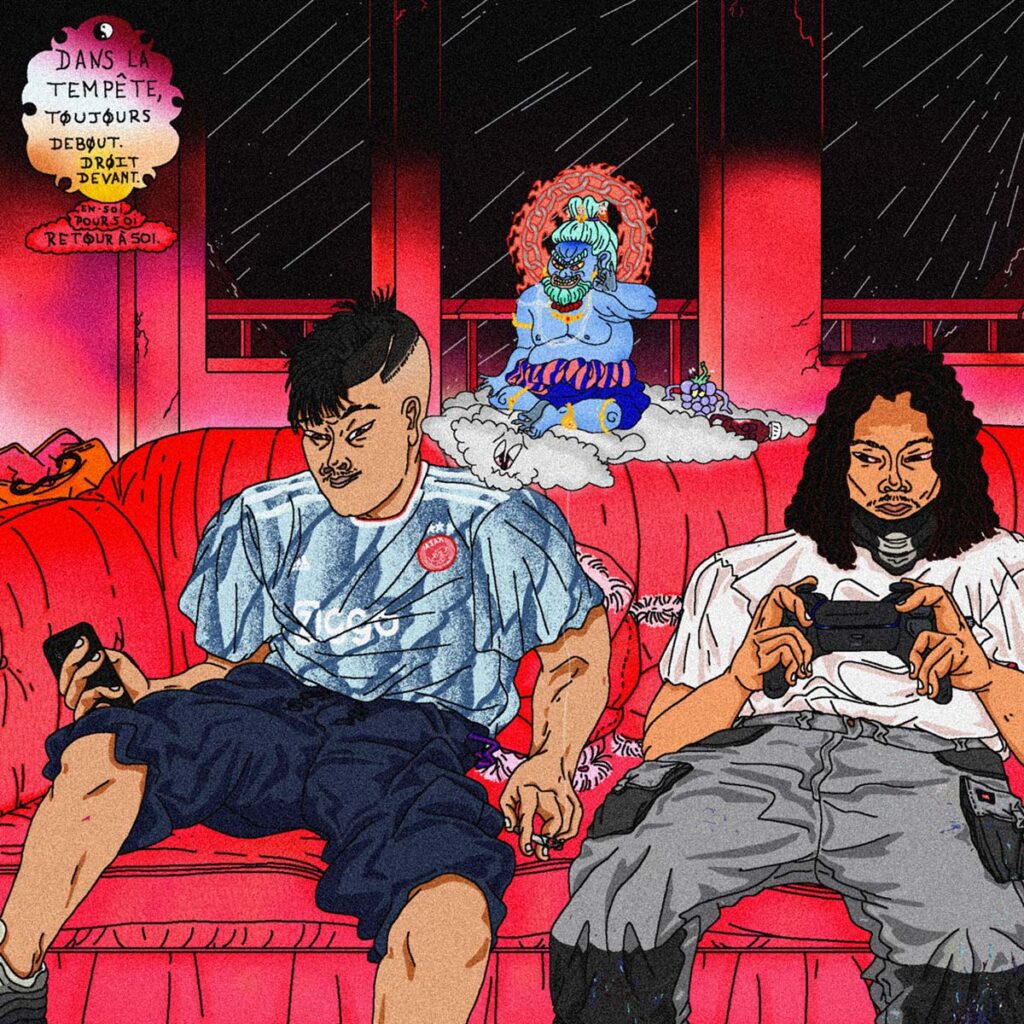
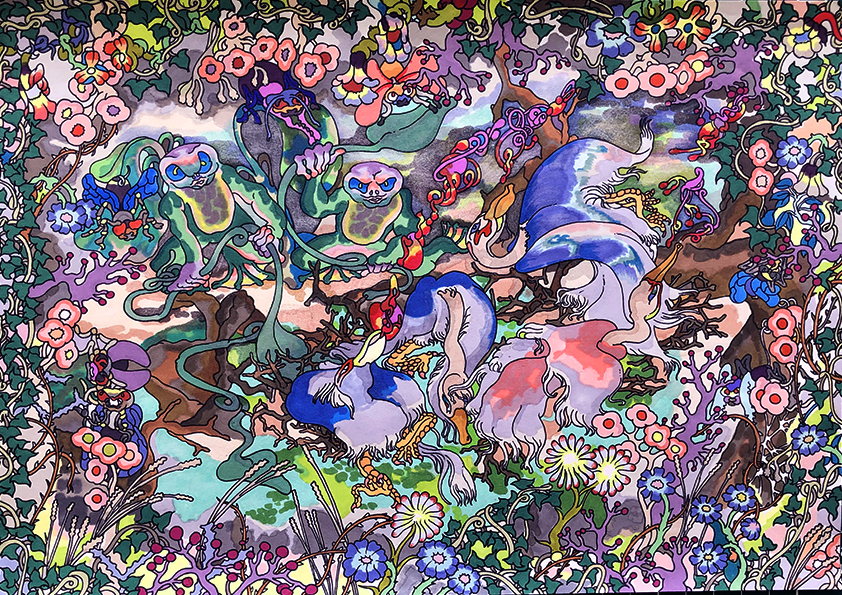

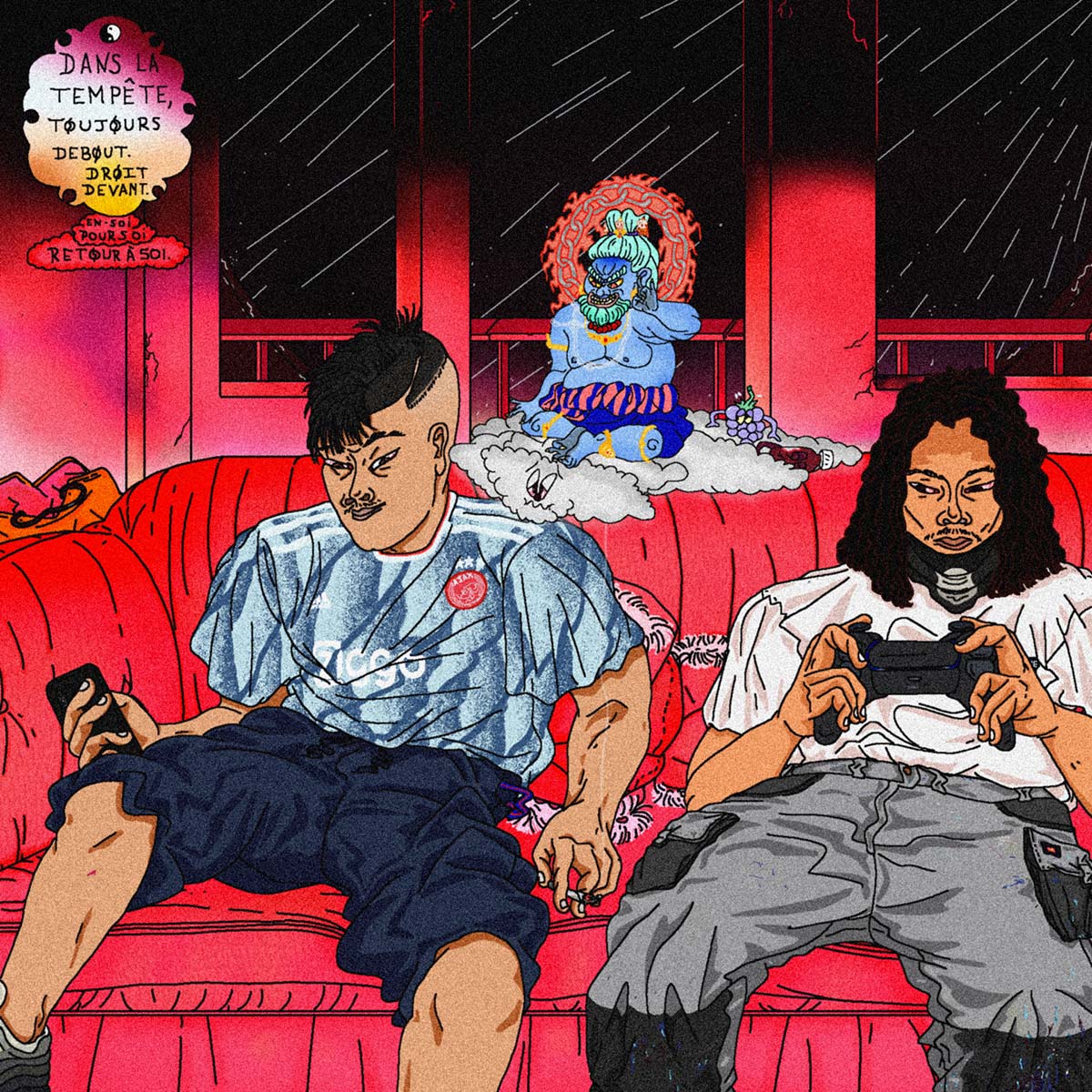

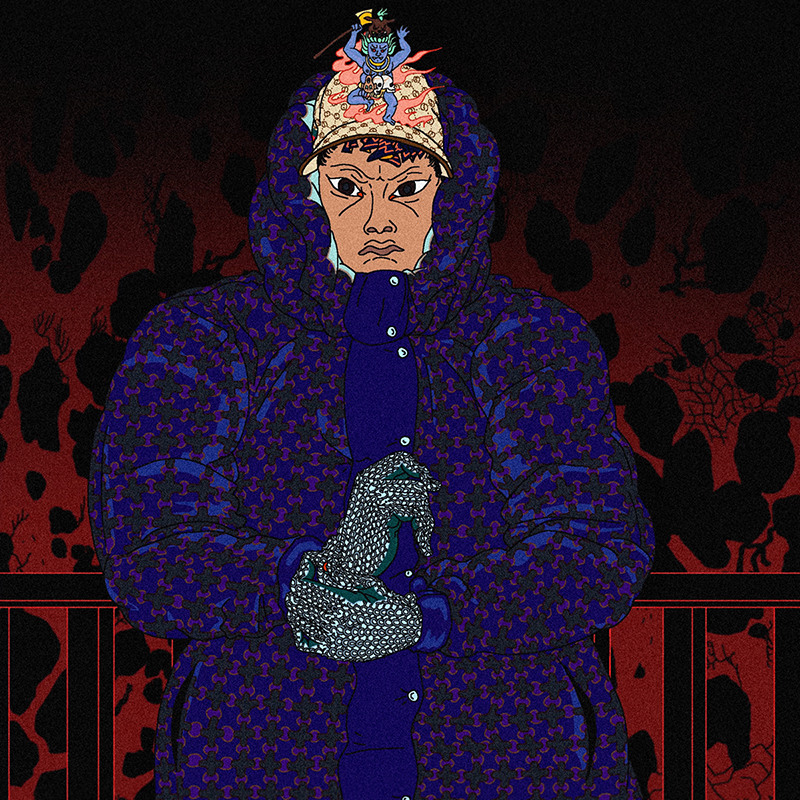


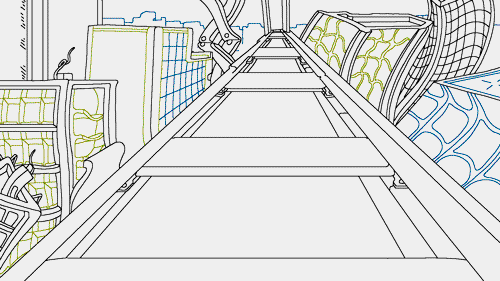


Thami and Hedi Nabil
MAY 2024
The power of image and storytelling in animation. Interview run by Melissa Rizkallah.
TEMPLE MAGAZINE
Could you share a bit about your backgrounds and artistic journeys?
THAMI NABIL
My work focuses on drawing and self-taught animation. At the moment, I engage in animation productions, either solo, as a duo or trio. I studied graphic design where I learnt how to compose images, and how to use softwares like Photoshop, Illustrator, Indesign, and a bit of After Effect. Graphic design gave me a deeper understanding of image alongside its tools which was my entry to the drawing sphere.
HEDI NABIL
I focus on drawing, illustration, and animation which I am still learning through the help of a handbook. I studied at Beaux-Arts in Paris, and I did an illustration school in Belgium. During my studies, I had to complete an exercise of producing a minute of animation. I guess my first approach to animation was based on a more traditional method because for me, even though softwares relie on digital practice, I decided to engage with physical drawings and scans. Of course, the traditional method is way more complex based on using different layers where drawings and colors are layered on top of each other, but it’s a method less prevalent today.
TEMPLE MAGAZINE
Indeed, that traditional method is the original approach to producing animation. However, it is a time-consuming technique that has prompted the development of new production methods utilizing software to tackle time constraints in production.
HEDI NABIL
Absolutely. The thing is you can still do hand-drawn animation, but for the sake of time and efficiency, we introduced softwares, and the technique of animation production evolved towards a common practice of softwares to align with deadlines. Personally, my education revolved around a physical approach to mediums, so animation seemed quite distant to me. On the other hand, Thami with his knowledge of softwares had all the tools to experiment freely with animation. I am aware the traditional method became really challenging to implement today, but I would love to try it once, as I prefer its render closer to painting in a way.
TEMPLE MAGAZINE
You both come from different backgrounds. At what point did animation emerge as a new creative medium for you?
HEDI NABIL
Thami got into it first. He wanted to create GIFs.
THAMI NABIL
Indeed, I liked the aesthetics of GIFs, compressed images, the idea of creating a loop. At first I failed reproducing it, but after some research, I found a way to draw, animate and make GIFs. I was lucky to launch myself on Instagram in 2017. People from the music industry were interesting in what I was doing, and as their expectations differ from mine, I was able to approach the process and experiment more freely. At the beginning, people were willing to pay 300 euros for one minute animation, which was a good introduction to motivate me to start with it. Then, we met the production company and worked on our most serious project so far with Hedi.
TEMPLE MAGAZINE
How did this meeting between the two of you in the realm of animation come about? Thami, were you initially exploring GIFs and dabbling in animation, while Hedi, you were primarily focused on drawing?
HEDI NABIL
Just as everyone, I watched a lot of Japanese animation growing up, as these are widespread mediums in France. As I mentioned before, I had done a short animation format for school, but it was a forgotten idea in my mind. Originally, I do comics and illustration. I had already released a printed comic in partnership with the label Red Lebanese in 2015. I also designed album covers for the music artist Mad Rey. At that time, Thami was experimenting with animation, and Mad Rey saw what he was doing and asked him to produce a video clip. Since Thami knew I did album covers, he thought it made sense for us to collaborate together on this project. Through this project, animation came back to me, but this time it meant that I had to get into softwares.
THAMI NABIL
Thanks to Mad Rey’ cleverness, he brought a production company along to finance the project. This gave Hedi and I the opportunity to enter this field as professionals with no prior experience.
TEMPLE MAGAZINE
In terms of softwares, which one did you learn animation on and which one do you use now to produce animation?
HEDI NABIL
There are many animation softwares like TV Paint, Adobe Animate, or After Effects, which save time because they were designed to address this issue. However, animation is a sequence of images where you break down a movement, meaning that it takes longer, but it works just as well on Photoshop. To answer your initial question about how we got into animation, I think when you draw, you always have the "dream" of seeing your drawing move and bring another dimension to it.
THAMI NABIL
Animation also allows you to instantly project yourself into an environment. The real challenge in animation is more about its construction and succeeding to present a vision as simply and effectively as possible, which I think is also the weak point of being self taught. It brings the question of moving to longer formats, to build a story, to exchange ideas on sound and music, which I haven't tackled yet, even though it represents half the work.
HEDI NABIL
Animation creates a certain hypnosis, where sound added to the image allows the viewers to immerse themselves more easily in a world. In animation, sound is just as important as the image. The challenge in animation is also to have a method and to simply go straight to the point through a few images. Japan is probably the best for this method, but France is not so far away with the impressive work from the students of Gobelins school. In any case, when you produce in animation, as long as your drawing comes to life, you have what you need.
TEMPLE MAGAZINE
Currently, you're engaged in creating short 2D animation formats. How do you foresee the evolution of your work? Are you considering transitioning to longer formats or exploring experimentation with 3D animation?
THAMI NABIL
Making a feature film would be ideal. It would be a new exercise of storytelling and a real team project, which I have never experienced yet. I see it as a long term project, not right now. As a matter of 3D, if it's a collaborative project where someone skilled in 3D, whose universe I appreciate, aspires to merge our aesthetic together, 3D can be super cool to implement. I never thought about it, but actually it could also be a great idea to reflect on gaming aesthetics or storytelling alongside developers to create a video game as there are some incredible works out there. On my side, I never tried 3D and I don’t know much about it.
HEDI NABIL
A feature film could be very cool, but you have to do things in the right order. First, we should move away from the music video; build a story, whether it's narrative or emotional; make a short film, and then move on to making a feature film.
Going through the Temple magazine, I saw renderings in PS2 mode, which I really vibe with. Personally, I consider 3D more of a tool than a type of render. I don't have 3D as a tool, but I would like to as it saves a lot of production time. But, it's not a compulsory step as you can just have someone sharp in 3D in your team. That’s the beauty of teamwork!
THAMI NABIL
He’s right. We can be limited to what we want to achieve as we practice this discipline solo or as a duo handling everything from A to Z. If we aim to work on a project distributed on a bigger scale and based on a longer format, then it becomes crucial to have a team to work with, but we're not there yet.
TEMPLE MAGAZINE
Are you reflecting on these type of projects outside of your work on commission?
HEDI NABIL
Right now, I'm thinking about making a short film, but first, I need a simple, effective story that gets to the point. However, in terms of animation production I would need a team, but these are questions that will arise after this initial phase of reflection.
TEMPLE MAGAZINE
Manga and anime culture feel quite present within your work, which made me think of the influence of video games and 3D too. What are your inspirations that shape your visual identity?
THAMI NABIL
I'm not a gamer, but the last video game that blew me away was Hotline Miami 2 with its retro aesthetic. In video games, if we take GTA as an example, what's interesting as an 11- year-old French player is that you don't know anything about Los Angeles, the history of gangs, or rap, but the video game translates that ambiance so well. It doesn't mean it's the reality, but there's a cultural aspect that makes the gaming experience going beyond a simple story. As a player you receive and integrate an entire world. In terms of reference, that's what I'm looking for. The feeling of discovery inspires me a lot.
HEDI NABIL
In terms of influences, the aesthetics of old Japanese anime and video games are part of it, with video games like Dofus or Warcraft that immersed me in worlds where I wasn't just following the story but where I could directly act on it. What you see, what you hear, also inspire me.
TEMPLE MAGAZINE
The discussion often revolves around storytelling and narration. Do you prioritize storytelling in your creations?
HEDI NABIL
It’s not very complex, but we always try to do so. For Mad Rey's video clip, there was a real narrative. We are attached to create an atmosphere, an ambiance.
TEMPLE MAGAZINE
How do you integrate your references and ideas into your work when undertaking a project?
THAMI NABIL
I see work as a perpetual search to evolve the line and to gain perspective. We exchange lots of references and spend a lot of time producing images. Influences also come from what happens around us: the environment, people, emotions, architecture… I don't know if any of it translates well into our work, but we try to convey our perception of all these things which influence our creative process.
HEDI NABIL
When we work on commission, we rely a lot on mood boards, but of for us two, it's different. Personally, my references come from History. I like to pull the thread and go back to the origins of things. I like to have the feeling of discovering something new: a new aesthetic, a new world, as in video games. In direct references, there are animes, but as I dug deeper, it made me go back to Japanese engravings. For example, in Naruto, the nine-tailed demon fox is an entity found in Japanese prints, and that's what inspires me, to go back to the sources and understand things more deeply. I prefer classical art to modern art. I like to go back to the time of the Greeks, medieval art with illuminations, stained glass windows in churches, frescoes in caves... We must not forget that images also have this primary function of storytelling and narration, and that's what inspires us.

TEMPLE MAGAZINE
Could you share a bit about your backgrounds and artistic journeys?
THAMI NABIL
My work focuses on drawing and self-taught animation. At the moment, I engage in animation productions, either solo, as a duo or trio. I studied graphic design where I learnt how to compose images, and how to use softwares like Photoshop, Illustrator, Indesign, and a bit of After Effect. Graphic design gave me a deeper understanding of image alongside its tools which was my entry to the drawing sphere.
HEDI NABIL
I focus on drawing, illustration, and animation which I am still learning through the help of a handbook. I studied at Beaux-Arts in Paris, and I did an illustration school in Belgium. During my studies, I had to complete an exercise of producing a minute of animation. I guess my first approach to animation was based on a more traditional method because for me, even though softwares relie on digital practice, I decided to engage with physical drawings and scans. Of course, the traditional method is way more complex based on using different layers where drawings and colors are layered on top of each other, but it’s a method less prevalent today.

TEMPLE
Indeed, that traditional method is the original approach to producing animation. However, it is a time-consuming technique that has prompted the development of new production methods utilizing software to tackle time constraints in production.
HEDI NABIL
Absolutely. The thing is you can still do hand-drawn animation, but for the sake of time and efficiency, we introduced softwares, and the technique of animation production evolved towards a common practice of softwares to align with deadlines. Personally, my education revolved around a physical approach to mediums, so animation seemed quite distant to me. On the other hand, Thami with his knowledge of softwares had all the tools to experiment freely with animation. I am aware the traditional method became really challenging to implement today, but I would love to try it once, as I prefer its render closer to painting in a way.
TEMPLE
You both come from different backgrounds. At what point did animation emerge as a new creative medium for you?
HEDI NABIL
Thami got into it first. He wanted to create GIFs.
THAMI NABIL
Indeed, I liked the aesthetics of GIFs, compressed images, the idea of creating a loop. At first I failed reproducing it, but after some research, I found a way to draw, animate and make GIFs. I was lucky to launch myself on Instagram in 2017. People from the music industry were interesting in what I was doing, and as their expectations differ from mine, I was able to approach the process and experiment more freely. At the beginning, people were willing to pay 300 euros for one minute animation, which was a good introduction to motivate me to start with it. Then, we met the production company and worked on our most serious project so far with Hedi.

TEMPLE
How did this meeting between the two of you in the realm of animation come about? Thami, were you initially exploring GIFs and dabbling in animation, while Hedi, you were primarily focused on drawing?
HEDI NABIL
Just as everyone, I watched a lot of Japanese animation growing up, as these are widespread mediums in France. As I mentioned before, I had done a short animation format for school, but it was a forgotten idea in my mind. Originally, I do comics and illustration. I had already released a printed comic in partnership with the label Red Lebanese in 2015. I also designed album covers for the music artist Mad Rey. At that time, Thami was experimenting with animation, and Mad Rey saw what he was doing and asked him to produce a video clip. Since Thami knew I did album covers, he thought it made sense for us to collaborate together on this project. Through this project, animation came back to me, but this time it meant that I had to get into softwares.
THAMI NABIL
Thanks to Mad Rey’ cleverness, he brought a production company along to finance the project. This gave Hedi and I the opportunity to enter this field as professionals with no prior experience.

TEMPLE
In terms of softwares, which one did you learn animation on and which one do you use now to produce animation?
HEDI NABIL
There are many animation softwares like TV Paint, Adobe Animate, or After Effects, which save time because they were designed to address this issue. However, animation is a sequence of images where you break down a movement, meaning that it takes longer, but it works just as well on Photoshop. To answer your initial question about how we got into animation, I think when you draw, you always have the "dream" of seeing your drawing move and bring another dimension to it.
THAMI NABIL
Animation also allows you to instantly project yourself into an environment. The real challenge in animation is more about its construction and succeeding to present a vision as simply and effectively as possible, which I think is also the weak point of being self taught. It brings the question of moving to longer formats, to build a story, to exchange ideas on sound and music, which I haven't tackled yet, even though it represents half the work.
HEDI NABIL
Animation creates a certain hypnosis, where sound added to the image allows the viewers to immerse themselves more easily in a world. In animation, sound is just as important as the image. The challenge in animation is also to have a method and to simply go straight to the point through a few images. Japan is probably the best for this method, but France is not so far away with the impressive work from the students of Gobelins school. In any case, when you produce in animation, as long as your drawing comes to life, you have what you need.

TEMPLE
Currently, you're engaged in creating short 2D animation formats. How do you foresee the evolution of your work? Are you considering transitioning to longer formats or exploring experimentation with 3D animation?
THAMI NABIL
Making a feature film would be ideal. It would be a new exercise of storytelling and a real team project, which I have never experienced yet. I see it as a long term project, not right now. As a matter of 3D, if it's a collaborative project where someone skilled in 3D, whose universe I appreciate, aspires to merge our aesthetic together, 3D can be super cool to implement. I never thought about it, but actually it could also be a great idea to reflect on gaming aesthetics or storytelling alongside developers to create a video game as there are some incredible works out there. On my side, I never tried 3D and I don’t know much about it.
HEDI NABIL
A feature film could be very cool, but you have to do things in the right order. First, we should move away from the music video; build a story, whether it's narrative or emotional; make a short film, and then move on to making a feature film.
Going through the Temple magazine, I saw renderings in PS2 mode, which I really vibe with. Personally, I consider 3D more of a tool than a type of render. I don't have 3D as a tool, but I would like to as it saves a lot of production time. But, it's not a compulsory step as you can just have someone sharp in 3D in your team. That’s the beauty of teamwork!
THAMI NABIL
He’s right. We can be limited to what we want to achieve as we practice this discipline solo or as a duo handling everything from A to Z. If we aim to work on a project distributed on a bigger scale and based on a longer format, then it becomes crucial to have a team to work with, but we're not there yet.

TEMPLE
Are you reflecting on these type of projects outside of your work on commission?
HEDI NABIL
Right now, I'm thinking about making a short film, but first, I need a simple, effective story that gets to the point. However, in terms of animation production I would need a team, but these are questions that will arise after this initial phase of reflection.
TEMPLE
Manga and anime culture feel quite present within your work, which made me think of the influence of video games and 3D too. What are your inspirations that shape your visual identity?
THAMI NABIL
I'm not a gamer, but the last video game that blew me away was Hotline Miami 2 with its retro aesthetic. In video games, if we take GTA as an example, what's interesting as an 11- year-old French player is that you don't know anything about Los Angeles, the history of gangs, or rap, but the video game translates that ambiance so well. It doesn't mean it's the reality, but there's a cultural aspect that makes the gaming experience going beyond a simple story. As a player you receive and integrate an entire world. In terms of reference, that's what I'm looking for. The feeling of discovery inspires me a lot.
HEDI NABIL
In terms of influences, the aesthetics of old Japanese anime and video games are part of it, with video games like Dofus or Warcraft that immersed me in worlds where I wasn't just following the story but where I could directly act on it. What you see, what you hear, also inspire me.

TEMPLE
The discussion often revolves around storytelling and narration. Do you prioritize storytelling in your creations?
HEDI NABIL
It’s not very complex, but we always try to do so. For Mad Rey's video clip, there was a real narrative. We are attached to create an atmosphere, an ambiance.
TEMPLE
How do you integrate your references and ideas into your work when undertaking a project?
THAMI NABIL
I see work as a perpetual search to evolve the line and to gain perspective. We exchange lots of references and spend a lot of time producing images. Influences also come from what happens around us: the environment, people, emotions, architecture… I don't know if any of it translates well into our work, but we try to convey our perception of all these things which influence our creative process.
HEDI NABIL
When we work on commission, we rely a lot on mood boards, but of for us two, it's different. Personally, my references come from History. I like to pull the thread and go back to the origins of things. I like to have the feeling of discovering something new: a new aesthetic, a new world, as in video games. In direct references, there are animes, but as I dug deeper, it made me go back to Japanese engravings. For example, in Naruto, the nine-tailed demon fox is an entity found in Japanese prints, and that's what inspires me, to go back to the sources and understand things more deeply. I prefer classical art to modern art. I like to go back to the time of the Greeks, medieval art with illuminations, stained glass windows in churches, frescoes in caves... We must not forget that images also have this primary function of storytelling and narration, and that's what inspires us.
